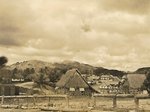
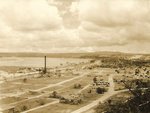
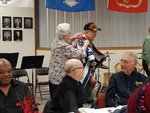

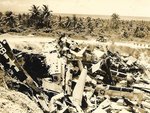
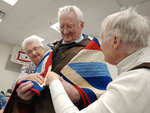
When Seaman First Class Lester Dingee, a Navy Seabee, drove a truck filled with dynamite toward the docks on Guam for destruction and disposal at sea, Japanese soldiers started firing at him.
He drove up a hill and saw something in the distance, but couldn’t make out what it was. He dropped down in a gully and when he drove over the lip of the next hill, three Japanese soldiers stood in the road with rifles.
“He saw that and he had no other choice,” said Jackie Smith of Aberdeen, who filled in for her father at the 22nd Annual World War II Veterans Remembrance Dinner at the Veterans Memorial Museum in Chehalis Sunday afternoon. “So he gunned it and he headed right for them, and they were firing at him, but they had to jump out of the way.”
A blast shattered the truck’s back window.
Dingee reached the docks, dynamite intact, but when he stepped out of the truck, his back felt sticky. Somebody told him he was bleeding.
“Medics pulled this eight-inch-long sliver of glass out of his back and stitched him up,” Smith said.
Dingee, 91, who had looked forward to speaking at the event but suffered a leg infection, grew up near Cranbury, New Jersey, and quit school at 14 to help on the family farm. When he was 16, friends told him he could make fast money boxing. Since he needed to be 18 to box, his manager found him a fake ID. He could earn $200 a night in the ring.
“Back then that was a lot of money,” Smith said. “But he decided he wanted to do his part, joining the service and, like I said, he became a Seabee.”
He was underage when he joined the Navy.
During World War II, Japanese forces confiscated the South Pacific island of Guam the day after they attacked Pearl Harbor in December 1941. Thirty-one months later, U.S. Marines with the III Amphibious Corp and the 77th Division landed on Guam July 21, 1944, and reclaimed the island. During the 21-day campaign, 1,744 Americans lost their lives and another 5,970 were wounded, according to the National Park Service. Japanese casualties on Guam were 18,000. On the Pacific islands Seabees repaired airfields, erected barracks, fixed damaged water systems and rebuilt roads, among other projects.
One time her dad and a buddy left camp to hunt deer but found themselves lost in the jungle overnight. He also heard rumors of a buried treasure on the island and searched for it at times.
Dingee, who has suffered a stroke and lives in Idaho, kept an album of photos from Guam, which he carefully labeled. He served overseas a year, returning to the States in 1946.
Four World War II veterans recognized at the dinner by Chip Duncan, the museum’s executive director, were Corporal Gilbert Proske, who served in the Military Police from 1942 to 1946; Private First Class David Liese, who served with the 1st Infantry Division from 1945 to 1946; Pharmacist’s Mate First Class Herbert Yantis, who served in the Pacific from 1943 to 1946; and Seaman Second Class Robert Gerard who served aboard the USS Biloxi (CL-80) from 1945 until 1952.
The museum’s Quilts of Valor chapter, part of a national organization started in 2003 to welcome returning troops with love, gratitude and comforting quilts, presented patriotic comforters with pillowcases to Proske and Gerard. Quilts of Valor has awarded 240,077 quilts nationally.
Duncan also recognized two women who worked in defense plants during the war — Helen Holloway, who worked in Chicago test-firing Army rifles and later inspecting airplane parts at Bendix Aviation, and Doris Bier, who assembled truck axles at the Mount Rainier Ordinance Department. He also recognized Robert Wheeler, who as a child was interned by the Japanese in the Philippines.
Twenty-two years ago, the museum’s World War II/Pearl Harbor event featured a live band and veterans dancing the jitterbug and Charleston. When they grew too old to dance, the museum held a dinner. A decade ago, nearly 150 veterans packed the upstairs room for the sold-out event. Eighty attended this year.
“But as time has passed, unfortunately, it has taken too many of the Greatest Generation,” Duncan said.
They may have died, but they’ll never be forgotten. Duncan said he’s a firm believer in the African proverb that states: “As long as you speak my name, I shall live forever.”
He asked those attending the dinner to share the names of WWII servicemen and women who have died and light a candle in their memory.
“The significance of lighting a candle is that it pierces the darkness and we want to pierce the darkness of forgetfulness,” Duncan said. “We do not want to forget these veterans who paid so much and gave so much of their lives for the very freedoms that we enjoy today. These veterans are precious. There was an entire world that was on the brink of losing freedom and this generation gave so much.”
Duncan said we need to remember the names of the millions of others who have gone before and left their mark on our lives.
“By the light of these candles that are lit here this evening, we are reminded of a generation that gave so much for all of us here,” Duncan said. “We live here today in freedom without a fear of want, without fear of oppression. … May the light that they brought to our lives and our country and the generations to come never be extinguished.”
•••
Julie McDonald, a personal historian from Toledo, may be reached at chaptersoflife1999@gmail.com.